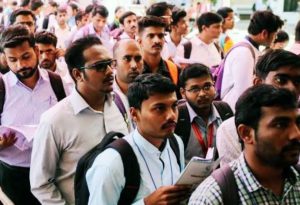AUGUST 29, 2020

India must be the only big economy (fifth largest in the world at nominal GDP of $2.94 trillion in 2019) which has no official estimate of its total workforce (only official unemployment rate is declared), how many have social security cover, how many lost their jobs due to the lockdown and how many get unemployment allowance.
On August 20, 2020 India announced “easing” of norms for unemployment allowance to cover those who lost their jobs due to the lockdown, but this is restricted to the “insured person” (IP) in the Employees State Insurance Corporation (ESIC) database. They are part of the 6% of total the workforce belong to organised sector.
The gazette notification for this is expected next month.
More than 94% workers have no unemployment allowance
The scheme under which this new unemployment allowance would be given is called Atal Beemit Vyakti Kalyan Yojana (ABVKJ), which came into existence on December 14, 2018. (“Beemit Vyakti” means insured person.)
According to the Parliamentary Standing Committee on Labour report of July 2020, the ESIC database has 34.9 million “insured persons” (IPs).
This number (34.9 million), however, is unreliable for two reasons.
One, it is not clear if the ESIC database has removed duplications (worker having changed job), those no longer eligible (having moved to higher salary) or dead/exhausted their unemployment entitlement, which is once in a lifetime.
Two, according to the Ministry of Labour and Employment’s official website, the total number of workers is estimated at 465 million, out of which 28 million (6%) are in “organized sector” and the rest 437 million (94%) in “unorganised sector”.
The Azim Premji University study of 2019, which analysed unit-level data of the government’s Periodic Labour Force Survey (PLFS) of 2017-18, estimated the total number of workers at 465.1 million in 2017-18 – which closely matches the labour ministry estimate.
Since the organised sector includes government employees (central and states), corporate sector employees and also those in the ESIC database, the insured persons in the ESIC alone can’t exceed the total number of organised workforce (28 million).
The ESIC database contains workers employed in factories with 10 or more workers with a monthly salary cap of Rs 21,000. They are, thus, a subset of the organised sector workers.
What about the rest 94% of the Indian workers in the unorganised sector?
There is no unemployment allowance for them.
Apart from the ESIC, there is one more legal provision for unemployment allowance: the central government-sponsored rural job guarantee scheme MGNREGS.
The MGNREGS workers are, however, not counted as “usual status” workers (neither in “principle status” nor “subsidiary status” employment) and hence, they are not part of the official count of workforce, says former chairman of the National Statistical Commission (NSC) PC Mohanan. He adds that the MGNREGS workers get reported only in the “daily status” surveys of the government.
Besides, there is no official estimate of how many of them have received unemployment allowance ever since the MGNREGS came into existence.
Who and how many will benefit from new unemployment allowance plan?
The original Atal Beemit Vyakti Kalyan Yojana proposed a “once in lifetime” unemployment allowance for a maximum of 90 days to the “insured” workers reporting jobless for three months. They are to get 25% of the average per day earning during the previous two years subject to the condition that they have fully contributed their share to the ESIC in the previous two years.
According to ESIC officials, 262 individuals have received a total of Rs 25 lakh as unemployment allowance under this scheme since December 2018.
On August 20, 2020, the scheme was modified to cover those who lost jobs due to the lockdown, which would remain in force until December 31, 2020. The new beneficiaries are entitled to 50% of their earlier average daily earnings in the previous two years, subject to the existing conditions.
The ESIC’s official estimate says 3.03 million out of 8.04 million suspected to have lost jobs due to the lockdown would benefit. Their job loss estimate (8.04 million) is based on missing contributions from the ESIC database during April-May 2020.
That is, only 37% of those who have lost their jobs (of 8.04 million) and 0.64% of the total Indian workforce of 465 million would get unemployment allowance.
What would be the amount of this allowance?
Assuming that an insured worker was getting a monthly salary of Rs 21,000 (the maximum limit for ESI coverage). The allowance works out to be Rs 345 per day (50% of the total earnings in 24 months divided by 730 days). A maximum payment for 90 days would mean Rs 31,068.
ESIC has estimates that the change would cost Rs 4,638 crore.
Since many more may lose their jobs during June-December 2020, it estimates an additional outgo of Rs 1,776 crore, taking the total to Rs 6,711 crore.
There is a second scheme under the ESIC that provides for unemployment allowance: Rajiv Gandhi Shramik Kalyan Yojana (RGSKY) of 2005.
Also Read: Rebooting Economy XIX: How India relies on low-paid ad hoc teachers for schooling children
The RGSKY applies only in cases where a factory is closed. According to ESIC officials, very few claims are filed under this scheme in normal times because proving closure of a factory is difficult. That is because the electricity connection to the factory may continue or the factory premise may be in use for other purposes etc.
The ESIC officials don’t expect any claim to be filed under this scheme in the current scenario.
What about job losses in unorganised sector?
The workers covered under the ESIC are organised sector workers.
What about the unorganised sector workers who are the hardest hit due to the lockdown?
There is no official data on such job loss.
That is because neither the labour ministry nor any other government agency is tracking it. Private estimates exist but vary widely and are of no use for official assistance. (For more read “Rebooting Economy VI: Is Modi govt ignoring job crisis in India or unable to tackle it? “)
This lack of data is not surprising because, officially, India does not even disclose the total number of COVID-19 cases.
Here is an interesting side. The homepage of the only official agency that provides the COVID-19 numbers, Ministry of Health and Family Welfare, is reproduced below. There is no sign of daily cases or total cases.
The daily cases are embedded in a link on the next page.
That page is replaced daily, removing the previous day’s data. Since the total cases are never disclosed, this page needs to be downloaded and saved every day from January 30, 2020 to determine the total caseload. On the other hand, it takes a few seconds to go to the Johns Hopkins’ COVID-19 tracker to know that India’s total caseload on August 25, 2020 stood at 3.17 million.)
The relevance of this will be clear soon.
Unemployment allowance under MGNREGS: A big mystery
The official website of MGNREGS does not disclose how many have received unemployment allowance since it was operationalised in 2006.
What this means is that not disclosing relevant information is not an accident.
Section 7(1) of the MGNREG Act of 2005 provides for unemployment allowance.
Also Read: Rebooting Economy XVIII: Does quality education really matter to India?
It reads: “If an applicant for employment under the Scheme is not provided such employment within fifteen days of receipt of his application seeking employment or from the date on which the employment has been sought in the case of an advance application, whichever is later, he shall be entitled to a daily unemployment allowance in accordance with this section.”
How does one find out how many are eligible or given unemployment allowance?
Researchers and activists working in the area say this can be found out by looking at the individual pages on panchayats in the MGNREGS’s MIS database. Since there are 250,000 pachayats in India nobody dares to get into it. Why can’t the MIS database provide a state-wise page for this as it does for other aspects of MGNREGS?
It is, however, relatively easier to find out how many demanded work but did not get it (unmet demand).
The MIS has a dedicated state-wise excel sheet on it. For example, its August 25, 2020 page shows 95.4 million individuals had demanded work since April 1, 2020, of which only 80.2 million got work during the same period and hence, the unmet demand stood at 15.2 million or 15.9% (of those who demanded work).
This page too is erased and replaced daily.
This MIS page does not reveal how many did not get work for 15 days, which is required to determine how many are eligible for the unemployment allowance.
The official strategy is evident: deny information and continue violating the law without being caught or questioned. The strategy has worked well since 2006.
Here is another way of looking at this data.
As on August 25, 2020, 15.2 million individuals sought manual MGNREGS work in rural India since April 1, 2020 but didn’t get (lockdown started on March 25, 2020).
Does that say something about the state of unemployment in rural India?
There is no such job scheme for urban jobless workers.
Is India serious about providing social security to workers?
The apathy to job loss, job security and unemployment allowance is systemic.
India introduced a new legislation, Code on Social Security, 2019, in the Lok Sabha in 2019 to provide social security to its unorganised sector workers (437 million).
That was the year that the PLFS 2017-18 report declared that the unemployment rate had reached a 45-year high at 6.1%. The Code of 2019 was expected to provide good protection to workers, especially the unorganised workers.
It did the opposite. It removed the unemployment allowance provided in its previous draft.
This was disclosed by the Parliamentary Standing Committee on Labour, which examined the Code of 2019 and submitted its report in July 2020.
Also Read: Rebooting Economy XVI: How governments run shadow banking and risk financial stability
It recorded the exchanges on unemployment allowance with the government.
The relevant part read: “Asked to state whether it was a fact that the Code on Social Security, 2019 had left out ‘unemployment allowance’ which was included in the earlier draft, the Ministry deposed as under: “As regards ‘unemployment allowance’ ESIC provides unemployment allowance to the insured persons (IP) through two schemes namely Rajiv Gandhi Shramik Kalyan Yojana and Atal Beemit Vyakti Kalyan Yojana…”
The panel’s own observations about the workings of the ESIC are revealing: “…the total number of workers/employees covered under the Scheme is even less than half of that covered by EPF when actually the threshold limit for EPF is twice than that of ESIC. The Ministry have reasoned that the coverage of ESIC is less due to the fact that the Scheme does not operate at an all India level and through the Social Security Code, the coverage of ESIC will extend to the entire country which will enhance coverage for the existing 3.49 crore families to 10 crore families…”
The panel took the government’s assertion at face value.
It didn’t strike the panel that the ESI Act was passed in 1948 and the ESIC under it was operationalised in 1952. If the ESI Act of 1948 couldn’t ensure all-India coverage of organised sector workers in 73 years (68 years of ESIC operations), how would the Code of 2019 do so and extend it from 34.9 million to 100 million and how many years would it take?
As for the social security cover for unorganised sector workers, the government told the panel: “For the unorganised workers basic social security has been taken care of in the proposed code.”
What is this basic social security system for unorganised workers in the Code of 2019?
The government said: “…clause 109(1)(vi) of the Code provides the flexibility to formulate schemes on any benefit as may be determined by the Central Government. The demand of universalisation including social security benefits for unorganised sector will be through formulation of schemes in the field of pension, insurance, Provident Fund, housing, medical, other benefits determined by the Central Government from time to time, etc.”
The panel did do some hard-talk about this though, pointing out several flaws in the Code of 2019: lack of comprehensive data on unorganised sector workers, lack of concrete schemes and funding mechanism, and lack of comparative study of social security programmes run by central and state governments to determine how to go about new schemes.
Ironically, 73 years after gaining independence, India is yet to provide social security cover to all organised workers, constituting just 6% of its total workforce.
As for the rest 94% of its workforce, unorganised sector workers, they would have to wait for years before the Code of 2019 brings about a comprehensive database, formulates schemes, finalises funding before any benefit reaches them.
Courtesy/Source: Business Today

































































































